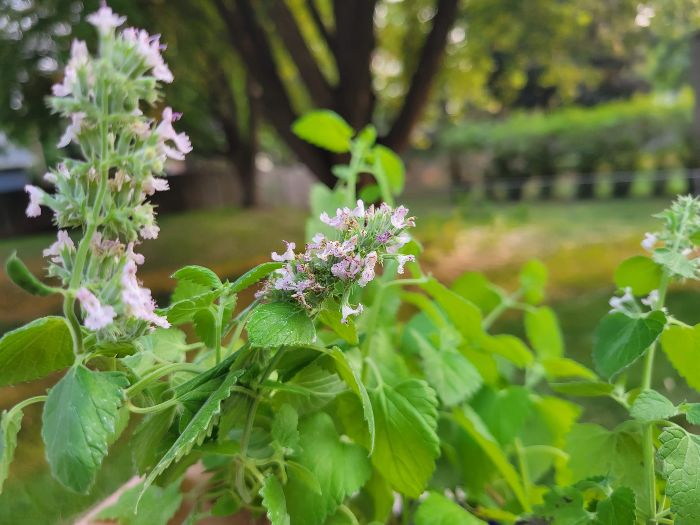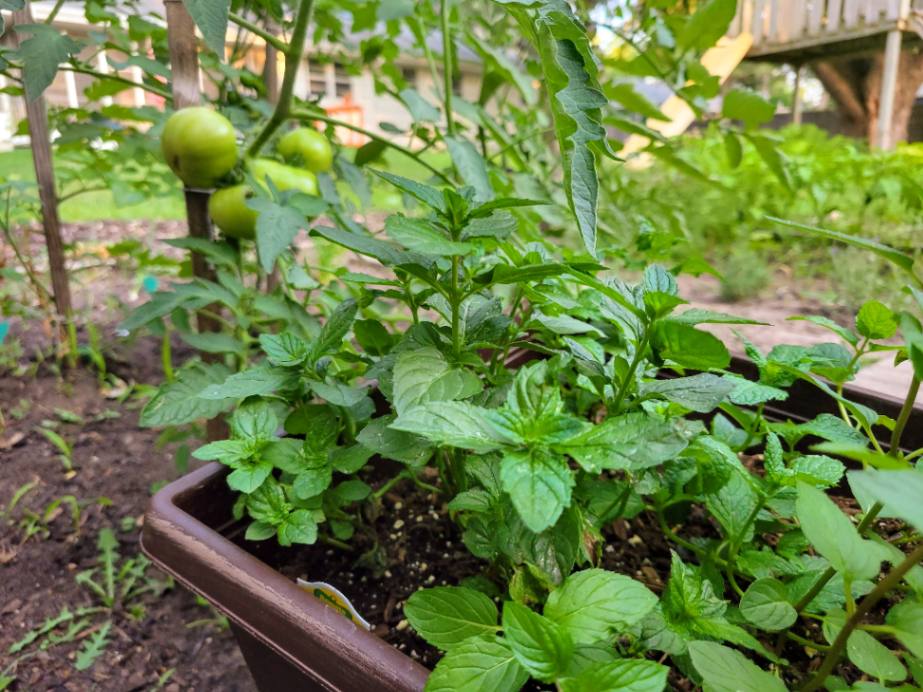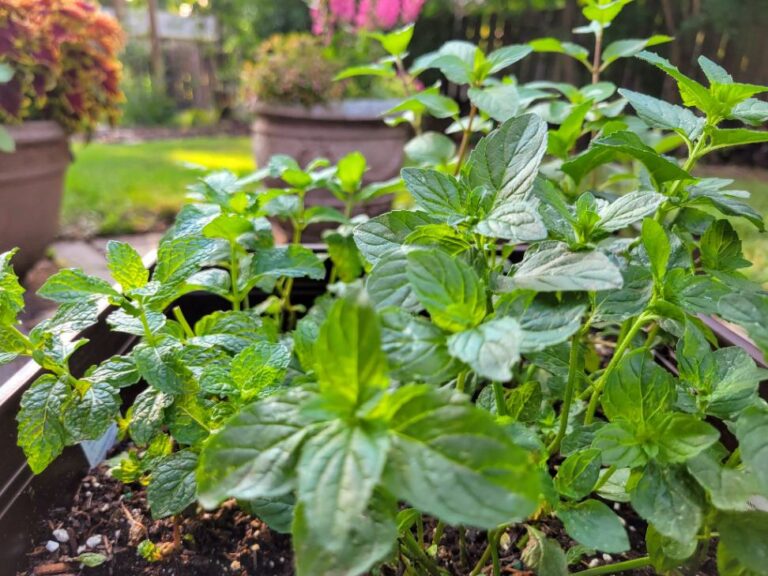This post may contain affiliate links which means I may receive a commission for purchases made through links. I only recommend products that I have personally used. As an Amazon Associate I earn from qualifying purchases. Learn more on my Private Policy page.

There are many types of mint, each boasting its own unique characteristics, from the classic spearmint to the exotic chocolate mint.
Belonging to the Mentha genus, mint varieties have been cherished for centuries due to their wide range of culinary applications. Whether adding a hint of freshness to a cocktail or using mint in culinary dishes, there is tremendous variation in the mint family.
The most common types of culinary mint to grow in your home garden are spearmint and peppermint, but a wide range of mint varieties can be cultivated. Other types of mint for cooking include chocolate mint, apple mint, Corsican mint, yerba buena, and ginger mint, among others.
Let’s explore the 13 types of mint you can grow in your culinary herb garden.
Table of Contents
Peppermint
Peppermint (Mentha x piperita) is a popular and versatile herb with a refreshing flavor and aroma. Peppermint boasts deep green smooth and glossy leaves that are tinged with hints of purple. It produces clusters of small purple flowers that add a pop of color.
Purchase peppermint plants or seeds from Amazon or SeedsNow

Flavor of Peppermint
Peppermint reigns supreme with its strong menthol profile. The high menthol content in peppermint gives this herb a sharp, cool, and refreshing taste that lingers on the palate. Peppermint has the highest menthol content of any member of the mint family; peppermint oil is comprised of 40% menthol.
Peppermint Growing Conditions
Peppermint thrives best in moist soil and partial shade environments. It prefers soil that retains water well but also has good drainage to prevent waterlogging. Providing partial shade helps protect the plant from scorching sunlight while still allowing it to receive adequate light for growth. Like most mints, peppermint can spread quickly, so many gardeners prefer to grow peppermint in containers.
Peppermint is very cold tolerant and is suitable for cultivation in Zones 3-9 according to the USDA Hardiness Zone Map. This means it can withstand cold temperatures down to -40°F in the winter without sustaining significant damage.
Culinary Uses of Peppermint
The culinary applications for peppermint are vast and varied. Its strong flavor makes it an excellent addition to a wide range of dishes and beverages. Some popular ways to incorporate peppermint into your culinary creations include:
- Teas: Brew a refreshing cup of peppermint tea by steeping fresh or dried leaves in hot water.
- Desserts: From ice creams and chocolates to cakes and cookies, peppermint adds a delightful twist to sweet treats. Finely chopped fresh peppermint leaves can be used as toppings or mixed into batters for a burst of minty flavor.
- Salads: Fresh peppermint leaves can be chopped and added to fruit salads or green salads to add flavor and fragrance.
- Marinades: To add a unique flavor and aroma, peppermint leaves can be included in marinades for meats, especially lamb or pork.
Spearmint
Beloved for its vibrant serrated green leaves and delicate flowers that range in color from pale purple to white, spearmint (Mentha spicata) is one of the most recognized types of mint.
Purchase spearmint plants from Amazon or spearmint seeds from SeedsNow

Cultivating Spearmint
Spearmint thrives best in full sun or partial shade, making it a relatively easy plant to care for. With a hardiness zone from 3 to 9, spearmint is a resilient plant that can handle a variety of climates, from chilly northern regions to warmer southern locales. When growing spearmint in your garden, keep in mind that it has a tendency to spread rapidly due to its vigorous growth habit. To prevent it from taking over your entire garden bed, consider planting spearmint in containers or using barriers to control its expansion.
Spearmint Flavor Profile and Culinary Uses
Spearmint is characterized by a refreshing menthol flavor that cools and invigorates the palate while having a milder and sweeter taste than peppermint.
Spearmint has found its way into numerous dishes around the world.
- Mediterranean Cuisine: Spearmint is commonly used in Mediterranean dishes, such as tabbouleh, mint tzatziki sauce, and lamb or chicken marinades, to add a unique and vibrant flavor.
- Desserts: Spearmint leaves can be used in desserts like ice cream, sorbets, and cakes to infuse a subtle minty taste.
- Mojitos and Cocktails: Spearmint is a key ingredient in classic cocktails like mojitos. Spearmint’s refreshing and strong menthol flavor pairs incredibly well with the rum’s sweetness and the lime’s tartness, making it an essential ingredient for this classic Cuban drink. In the world of cocktails, spearmint has a legendary status.
- Sauces and Dressings: Spearmint leaves can be incorporated into sauces, dressings, or dips, bringing a refreshing twist to savory dishes like yogurt-based sauces or vinaigrettes.
Spearmint is a versatile herb that is relatively easy to grow. From Mediterranean cuisine to desserts and cocktails, spearmint can add a refreshing menthol flavor to your kitchen creations.
Chocolate Mint
Chocolate Mint (Mentha x piperita ‘Chocolate’) is a particularly intriguing variety of mint. As the name suggests, this unique herb offers a tantalizing hint of chocolate in its flavor profile, making it a popular choice for chocolate aficionados. Chocolate mint features dark green leaves adorned with reddish veins.
Purchase chocolate mint plants from Amazon
Chocolate Mint Flavor Profile
What sets chocolate mint apart from other mints is its distinctive flavor. While it retains the refreshing qualities associated with all mints, it also possesses subtle chocolate undertones that can add depth and richness to desserts. Whether used as a garnish or infused into dishes, chocolate mint brings a delightful twist to your favorite sweet treats.
Growing Chocolate Mint
To cultivate chocolate mint plants, ensure your plants receive adequate sunlight and are planted in well-draining soil. While it can tolerate partial shade, chocolate mint prefers full sun exposure and will yield better flavor with more sunlight. Chocolate mint is very cold tolerant and is hardy to zones 3-9. Like most mints, chocolate mint can spread quickly, so most gardeners grow mint separately from the rest of their garden. By providing your chocolate mint with the right growing conditions, you’ll be rewarded with healthy and vibrant plants ready for culinary experimentation.
Culinary Uses: Desserts, Hot Chocolate, and Ice Cream
The culinary applications of chocolate mint are truly versatile. Its unique flavor makes it an excellent addition to a wide range of desserts, including cakes, cookies, and brownies. You can also experiment with infusing the leaves into hot chocolate for a delightful twist or incorporating them into homemade ice cream for a refreshing treat.
Apple Mint
Apple mint (Mentha suaveolens) is a delightful variety of mint that adds a unique twist to culinary creations. With its sweet apple-like scent and taste, light green leaves, and slightly fuzzy texture, apple mint stands out among other mint plants.
Purchase apple mint plants from Amazon
Apple Mint Growing Conditions
Apple mint thrives in fertile soil and requires full sun exposure. With its robust growth, apple mint requires cultivation within designated boundaries to restrain its spreading tendencies and to maintain control in your garden. While not quite as tolerant of the extreme cold as some other mint varieties, apple mint is hardy in zones 5-9. Whether you’re an experienced gardener or just starting your herb garden, apple mint is relatively easy to cultivate.
Flavor Profile and Culinary Uses of Apple Mint
Apple mint boasts a unique flavor profile that combines mint’s fresh and cooling qualities with a subtle hint of apple. It is commonly used in fruit salads, herbal teas, cocktails, and infused water, imparting a pleasant and invigorating flavor. Apple mint can also be incorporated into marinades, sauces, and desserts, providing a touch of freshness and a hint of apple to elevate the overall taste experience. Whether used as a garnish or an ingredient, apple mint adds a delightful and unexpected element to culinary creations.
Banana Mint
Banana mint (Mentha × piperita ‘Banana’) is a mint variety that offers a unique twist to your cooking. The distinct banana-like fragrance combined with the characteristic mint flavor makes banana mint a versatile ingredient that pairs well with tropical-inspired dishes and beverages.
Purchase banana mint plants from Amazon
Banana Mint Cultivation
Banana mint thrives in full sun or partial shade. While not quite as invasive as most other members of the mint family, banana mint still needs to be kept in check after a few growing seasons to ensure it does not take over the garden. Banana mint is hardy in zones 5-9, prefers well-drained soil, and requires regular watering for optimal growth.
Culinary Uses of Banana Mint
With its unique minty flavor profile reminiscent of bananas, banana mint offers a range of possibilities in the kitchen.
- Fruit Salads: Banana mint can be a delightful addition to fruit salads for a fresh and fragrant twist. Consider adding slices of ripe bananas, grapefruit segments, and other juicy fruits alongside sprigs of banana mint for an invigorating summer treat.
- Salad Dressings: Finely chopped banana mint leaves can be added to homemade salad dressings, providing a subtle banana note that complements both green salads and fruit-based salads.
- Desserts: Banana mint can be used in desserts like sorbets, ice creams, and fruit-based desserts to infuse a unique banana-mint flavor. It works particularly well with chocolate or tropical fruit desserts.
- Cocktails: Banana mint leaves can be muddled (lightly mashed) and used in cocktails for a tropical and refreshing twist. They can enhance the flavors of rum-based drinks or fruit cocktails, or even mojitos.
Corsican Mint
Corsican Mint (Mentha requienii) is a small, low-growing mint variety that forms mats of tiny bright green leaves that grow densely together. Corsican mint grows to be only 1-3 inches (3-10 cm) tall and is one of the smallest varieties of mint plant available.
Purchase Corsican mint plants from Amazon

One notable feature of Corsican mint is its strong peppermint aroma. Its leaves release a refreshing scent that has made this variety popular for use in potpourri and as an air freshener.
Corsican mint thrives in moist soil and partial shade. It is often cultivated between pavers or used as ground cover due to its ability to spread quickly and form a carpet-like appearance. This makes it an excellent choice for filling gaps or creating lush areas in your garden. In terms of hardiness zones, Corsican mint is suitable for Zones 6-9.
The versatility of Corsican mint extends beyond its visual appeal and fragrance. Its culinary applications are also worth exploring. The leaves possess a mild yet distinct flavor that adds a refreshing twist to various dishes and beverages. Whether you’re preparing salads, cocktails, or desserts, incorporating Corsican mint can elevate the taste profile with its subtle notes.
Yerba Buena
Yerba Buena (Clinopodium douglasii) is a delightful herb that adds a unique touch to any herb garden. Translated as “good herb” in Spanish, Yerba Buena has small leaves and a minty flavor with hints of citrus and has gained popularity in both Latin American and Filipino cuisine.
Purchase Yerba Buena mint plants from Amazon

Growing Conditions for Yerba Buena
Yerba Buena thrives in partial shade and well-drained soil. It is a hardy plant that can withstand a variety of conditions. Yerba Buena is not particularly cold tolerant, thriving in USDA Zones 7-11. It grows up to 7” (18cm) in height and can spread out to 3’ wide (0.9m).
Culinary Uses
Yerba Buena possesses a refreshing and minty taste, reminiscent of traditional mint leaves. The aromatic qualities of Yerba Buena make it an excellent choice for teas, infusions, and herbal blends. It can be used to add a refreshing twist to beverages, such as iced teas or cocktails. In culinary recipes, Yerba Buena leaves can be utilized as a flavoring agent in salads, dressings, sauces, and desserts. Often used in Latin American and Filipino cuisine, its distinct minty flavor complements both sweet and savory dishes, adding a pleasant aroma and taste to foods when used fresh or dried.
Curly Mint
Curly mint (Mentha spicata ‘Crispa’), also known as curly spearmint, stands out from other mint varieties due to its distinctively fuzzy leaves that are tightly curled, creating an eye-catching texture.
Curly Mint Flavor: Milder than Spearmint
While curly mint shares similarities with spearmint, it possesses a milder flavor profile. The taste is refreshingly minty but less intense compared to its straight-leaved counterpart. This makes it an excellent choice for those who prefer a more subtle hint of mint.
Growing Conditions of Curly Mint
Curly mint thrives best in well-draining soil that retains moisture without becoming waterlogged. It requires ample sunlight exposure to flourish, so planting it in an area with full sun is essential for optimal growth. Curly mint grows well in USDA hardiness zones 3 through 9. Its adaptability allows gardeners from various regions to enjoy cultivating this delightful herb.
Curly Mint Culinary Uses
In the kitchen, curly mint offers versatility in its culinary applications. Its attractive curled leaves make for an exceptional garnish, adding a touch of visual appeal to both sweet and savory dishes.
- Sprinkle freshly chopped curly mint over salads for an invigorating burst of flavor.
- Add it to soups or stews towards the end of cooking for a fragrant twist.
- Use it as a delightful garnish for cocktails, lending both aesthetic appeal and aromatic notes.
- Curly mint can be infused into teas, providing a refreshing and minty flavor that complements various blends.
By experimenting with curly mint in different dishes, you can explore its unique flavors and discover exciting combinations that suit your palate.
Ginger Mint
Ginger mint (Mentha x gentilis) is a delightful hybrid of corn mint and spearmint. Its vibrant green leaves with serrated edges make it visually appealing in any garden or herb collection.
Ginger mint offers a delightful flavor blend of spicy ginger and refreshing mint. The combination creates a taste that is both invigorating and soothing at the same time.
Ginger Mint Growing Conditions
Ginger mint thrives in moist soil and prefers partial shade, although it can tolerate full sun as well. Hardy in zones 5-9, ginger mint adapts well to various growing conditions, making it relatively easy to cultivate. Whether you have a sunny spot in your backyard or a shady corner on your balcony, ginger mint will happily grow there.
Culinary Uses of Ginger Mint
One of the most exciting aspects of ginger mint is its versatility in culinary applications. With its unique flavor profile, this herb can add depth and complexity to various dishes and beverages:
- Teas: Ginger mint leaves can be infused in hot water to create a refreshing and soothing herbal tea.
- Cocktails: Add a sprig of ginger mint to your favorite cocktails for an extra kick of flavor. Its aromatic presence will elevate the taste and presentation of any mixed drink.
- Asian-inspired dishes: Ginger mint is an excellent addition to Asian-inspired recipes, bringing a fresh and zesty element to stir-fries, salads, and marinades.
Cat Mint (Catnip)
Cat mint (Nepeta cataria), commonly known as catnip, is a popular herb that belongs to the mint family. The leaves of cat mint are characterized by their gray-green color and jagged edges, providing a distinctive appearance that sets it apart from other plants.
Purchase cat mint (catnip) plants from Amazon or catmint seeds from SeedsNow

One of the most fascinating aspects of cat mint is its effect on cats. When exposed to this herb, many felines exhibit behaviors ranging from playful excitement to pure bliss. This unique response can be attributed to a compound called nepetalactone, which triggers a euphoric reaction in cats when they smell or consume it. As a result, cat owners often use catnip-infused toys or treats to provide entertainment and enrichment for their furry companions.
Cat mint thrives best under specific conditions. Full sun exposure or partial shade is ideal for these plants, along with well-drained soil that allows proper root development. Cat mints are hardy in zones 3-9, making them suitable for cultivation in diverse climates.
Caring for cat mint requires minimal effort but yields rewarding results. Regular watering is necessary during dry periods to ensure the plant’s vitality and growth. Pruning the plant after flowering helps maintain its shape and encourages new growth.
Cat mints can be grown both as ground cover or potted plants depending on personal preferences and available space. Their versatility allows them to enhance gardens with their attractive foliage while also serving as indoor companions for cats.
Lavender Mint
Lavender mint (Mentha x piperita ‘Lavender’) is a unique herb that combines the soothing scent of lavender with the refreshing taste of mint. Its leaves have a distinct grayish-green color with subtle purple undertones.
This aromatic herb adds depth and complexity to both desserts and savory dishes, with its delicate floral notes of lavender blending harmoniously with the taste of mint.
Purchase lavender mint plants from Amazon
Growing Conditions of Lavender Mint
Lavender mint is relatively easy to grow, provided it receives proper care and attention. Lavender mint thrives in well-drained soil, requires full sun exposure, and is hardy in zones 5 to 9.
Versatile Culinary Uses of Lavender Mint
Lavender mint is highly versatile in the kitchen, offering a wide range of uses. This herb serves as an aromatic addition to desserts, baked goods, and a wide variety of other culinary applications.
- Sprinkle freshly chopped leaves over fruit salads for an added burst of freshness.
- Mix minced lavender mint into yogurt for a unique twist on a classic snack.
- Incorporate this herb into marinades for grilled meats or vegetables.
- Add finely chopped leaves to homemade salad dressings or vinaigrettes.
- Infuse cream or milk with dried lavender flowers and use it as a base for ice cream or custards.
As you experiment with different recipes utilizing lavender mint, you’ll discover the numerous possibilities it offers to elevate your dishes.
Lemon Balm
Lemon balm (Melissa officinalis) is an herb belonging to the mint family. While it shares some similarities with its mint counterparts, lemon balm has its own distinct lemony flavor and scent. Its leaves are light green with scalloped edges, making it easily recognizable in gardens or pots.
Purchase lemon balm plants from Amazon or lemon balm seeds from SeedsNow

Lemon balm is quite versatile. It can thrive in both full sun and partial shade, making it an excellent choice for various garden settings. Lemon balm exhibits hardiness in zones 4-9, making it suitable for a wide range of climates.
One of the most popular uses of lemon balm is in herbal teas. The refreshing citrus aroma and taste make it a perfect ingredient for creating soothing and flavorful beverages. Its bright flavor also pairs well with both sweet and savory dishes. From baked goods like cakes and cookies to salads and sauces, lemon balm adds a unique twist to any recipe.
Moroccan Mint
Moroccan mint (Mentha spicata ‘Moroccan’) is a variety of mint known for its role in making Maghrebi tea or “Moroccan” tea in North African culture. The leaves of Moroccan mint are vibrant and bright green, adorned with serrated edges, and they boast a refreshing spearmint-like flavor profile.
Moroccan mint thrives in both full sun and partial shade. This flexibility allows gardeners to cultivate this herb in various locations. It’s worth noting that Moroccan mint is not as cold-hardy as some other mint varieties, and is most suitable for hardiness zones 6-9, so keep this in mind when planning your herb garden.
Moroccan mint plays an integral role in North African culture. Moroccan mint is highly valued for making traditional Maghrebi tea or “Moroccan” tea, a beverage deeply ingrained in the region’s customs and traditions. This aromatic infusion combines gunpowder green tea leaves with generous amounts of fresh Moroccan mint leaves and copious amounts of sugar. The result is a fragrant and flavorful tea that warms both body and soul.
How to Choose Types of Mint for Cultivation
When choosing which type of mint to cultivate, there are several factors to consider. Understanding your hardiness zone, the growing conditions available in your garden, the existing plant life, as well as your own culinary preferences are all key to deciding which mint variety is right for you.

Here’s how to evaluate each of these considerations:
Evaluate Hardiness Zone When Selecting Mint Varieties
The first factor to consider is your hardiness zone. Mint is generally a sturdy plant and can be grown in many zones, but there are slight variations in the hardiness of different mint types. For instance, spearmint (Mentha spicata) thrives in zones 3-9, while Corsican mint (Mentha requienii) prefers a more Mediterranean climate and is best suited for zones 6-9. By identifying your hardiness zone, you can narrow down which types of mint are most likely to thrive in your region.
Mint plants typically do well with partial shade, but some varieties are more sun-loving than others. Mint generally prefers well-draining, rich, moist soil with a pH between 6.0 and 7.0. However, some types of mint can be more flexible. For instance, Corsican mint can handle slightly dry soil better than most other types.
If your garden soil is heavy clay or sandy, you may want to consider improving it with organic matter or growing your mint in raised beds or pots. Mint is a vigorous grower and will spread quickly, so container planting can also help keep your mint in check.
Mint Soil and Sunlight Preferences
Companion Planting with Mint
As you consider where to plant your mint, bear in mind that while it can be an excellent companion plant for certain types of vegetables and herbs, it is also an extremely aggressive grower. Mint companion planting can deter pests that commonly affect tomatoes and cabbages. However, due to its invasiveness, it’s advisable to plant mint in its own container or a separate section of the garden to prevent it from overtaking other plants.

Culinary Preferences in Mint Selection
Finally, your choice of mint variety might be influenced by your culinary preferences. If you’re a fan of mojitos or mint juleps, you might want to grow spearmint or yerba buena (Satureja douglasii) for their classic, refreshing mint flavor. Peppermint (Mentha x piperita) is known for its high menthol content, making it a great option for teas and soothing balms.
For a twist, you might consider some of the more unique varieties. Chocolate mint, for instance, carries a delightful aroma and flavor that combines traditional mint with subtle notes of chocolate, making it a fun addition to desserts. Apple mint (Mentha suaveolens) offers a slightly fruity flavor, perfect for fruit salads, and ginger mint (Mentha x gracilis) brings a warm spiciness that can liven up sauces and marinades.
By considering these factors, you’ll be well on your way to choosing the perfect mint variety for your garden. Once you’ve made your decision, you can look forward to enjoying the fresh, invigorating aroma and flavor that only home-grown mint can offer. Happy planting!
Frequently Asked Questions (FAQs)
Can I grow different types of mint together in my garden?
Different types of mint can be grown together in your garden. However, keep in mind that some varieties tend to spread aggressively through underground runners. To prevent them from taking over your garden space, consider planting your mint in a container (or even planting each type of mint in a separate container) or using barriers like plastic edging.
What is the best mint for cooking?
Spearmint is generally the preferred variety of mint for cooking due to its sweet flavor profile and subtle, less overpowering aroma compared to other types. Its balanced, refreshing taste makes it an ideal ingredient in a wide array of dishes, from savory sauces and salads to desserts and beverages.
How do I know which mint variety is best for making tea?
The best mint varieties for making tea are typically those with a strong and pleasant aroma. Peppermint, spearmint, lemon balm, and Moroccan mint are popular choices for brewing flavorful herbal teas. Experiment with different varieties to find the one that suits your taste preferences.
Can I use any type of mint in cooking?
You can use various types of mint in cooking. However, keep in mind that each variety has its own distinct flavor profile. Peppermint and spearmint are commonly used in both sweet and savory dishes, while chocolate mint adds a unique twist to desserts. Consider the specific taste you want to achieve when selecting a mint variety for cooking.
Can I grow different types of mints indoors?
Different types of mint can be grown indoors as long as they receive adequate sunlight or artificial light. Mint plants generally thrive in well-draining soil and appreciate regular watering. Consider using pots or containers with good drainage to prevent waterlogging.
How long do mint plants typically live?
Mint plants are perennial herbs that can live for several years under favorable conditions. However, it’s important to note that some varieties may become less vigorous over time.
Last Updated on 28 April 2024 by Bob Lee

